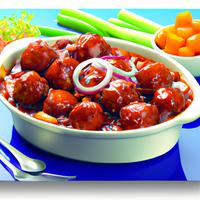
1 serving (150 grams) contains 200 calories, 5.0 grams of protein, 10.0 grams of fat, and 25.0 grams of carbohydrates.

Log this food in SnapCalorie

Nutrition Information
Calories |
317.5 | ||
|---|---|---|---|
% Daily Value* |
|||
| Total Fat | 15.9 g | 20% | |
| Saturated Fat | 3.2 g | 16% | |
| Polyunsaturated Fat | 0 g | ||
| Cholesterol | 0 mg | 0% | |
| Sodium | 952.4 mg | 41% | |
| Total Carbohydrates | 39.7 g | 14% | |
| Dietary Fiber | 4.8 g | 17% | |
| Sugars | 7.9 g | ||
| protein | 7.9 g | 15% | |
| Vitamin D | 0 mcg | 0% | |
| Calcium | 79.4 mg | 6% | |
| Iron | 2.4 mg | 13% | |
| Potassium | 476.2 mg | 10% | |
* Percent Daily Values are based on a 2,000 calorie diet. Your daily values may be higher or lower depending on your calorie needs.
Food Attributes
Source of Calories
About Vegetable manchurian
Vegetable Manchurian is a popular Indo-Chinese dish featuring deep-fried vegetable balls simmered in a flavorful, tangy sauce made with soy sauce, garlic, ginger, and a blend of spices. Typically, the vegetable balls are crafted from finely chopped cabbage, carrots, and other veggies bound with flour and fried to golden perfection. Known for its bold, savory profile, this dish strikes a balance between Chinese cooking techniques and Indian flavors. While packed with vegetables, Vegetable Manchurian’s healthiness depends on its preparation. The incorporation of fiber-rich veggies provides essential nutrients, while the use of soy sauce adds a dose of umami along with sodium. However, the deep-frying process increases calorie and fat content, making it less suited for those watching their fat intake. When prepared with less oil or baked alternatives, it can be a satisfying treat that offers a healthier take on comfort food.



